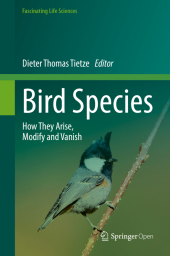 Neuerscheinungen 2018Stand: 2020-02-01 |
Schnellsuche
ISBN/Stichwort/Autor
|
Herderstraße 10
10625 Berlin
Tel.: 030 315 714 16
Fax 030 315 714 14
info@buchspektrum.de |

Dieter Thomas Tietze
Bird Species
How They Arise, Modify and Vanish
Herausgegeben von Tietze, Dieter Thomas
1st ed. 2018. 2018. xii, 266 S. 4 SW-Abb., 40 Farbabb., 40 Farbtabellen. 235 mm
Verlag/Jahr: SPRINGER, BERLIN; SPRINGER INTERNATIONAL PUBLISHING 2018
ISBN: 3-319-91688-2 (3319916882)
Neue ISBN: 978-3-319-91688-0 (9783319916880)
Preis und Lieferzeit: Bitte klicken
The average person can name more bird species than they think, but do we really know what a bird "species" is? This open access book takes up several fascinating aspects of bird life to elucidate this basic concept in biology. From genetic and physiological basics to the phenomena of bird song and bird migration, it analyzes various interactions of birds - with their environment and other birds. Lastly, it shows imminent threats to birds in the Anthropocene, the era of global human impact.
Although it seemed to be easy to define bird species, the advent of modern methods has challenged species definition and led to a multidisciplinary approach to classifying birds. One outstanding new toolbox comes with the more and more reasonably priced acquisition of whole-genome sequences that allow causative analyses of how bird species diversify.
Speciation has reached a final stage when daughter species are reproductively isolated, but this stage is not easily detectable from the phenotype we observe. Culturally transmitted traits such as bird song seem to speed up speciation processes, while another behavioral trait, migration, helps birds to find food resources, and also coincides with higher chances of reaching new, inhabitable areas. In general, distribution is a major key to understanding speciation in birds. Examples of ecological speciation can be found in birds, and the constant interaction of birds with their biotic environment also contributes to evolutionary changes. In the Anthropocene, birds are confronted with rapid changes that are highly threatening for some species. Climate change forces birds to move their ranges, but may also disrupt well-established interactions between climate, vegetation, and food sources.
This book brings together various disciplines involved in observing bird species come into existence, modify, and vanish. It is a rich resource for bird enthusiasts who want to understand various processes at the cutting edge of current research in more detail. At the same time it offers students the opportunity to see primarily unconnected, but booming big-data approaches such as genomics and biogeography meet in a topic of broad interest. Lastly, the book enables conservationists to better understand the uncertainties surrounding "species" as entities of protection.
"More than 40 tables and attractive illustrations help to enhance what many may find to be a difficult, highly advanced text, loaded with acronyms and graduate-level terminology, ... Summing Up: Recommended. Graduate students, researchers, and professionals." (H. T. Armistead, Choice, Vol. 56 (11), July, 2019)
Dieter Thomas Tietze studied the integrative taxonomy of passerine birds with Jochen Martens at Mainz University (doctoral scholarship from Villigst) and then broadened his focus at the Zoological Museum in Dresden (phylogeography), the University of Chicago (DFG research fellowship; community ecology and phylogeny of Himalayan passerine birds), and the Universities of Frankfurt am Main (historical biogeography, trait evolution) and Heidelberg (avian urban ecology, genomics). He has served on various conservation NGOs and the advisory board of the German Ornithologists´ Society (DO-G). He is currently Vertebrate Curator at the Natural History Museum in Basel.


